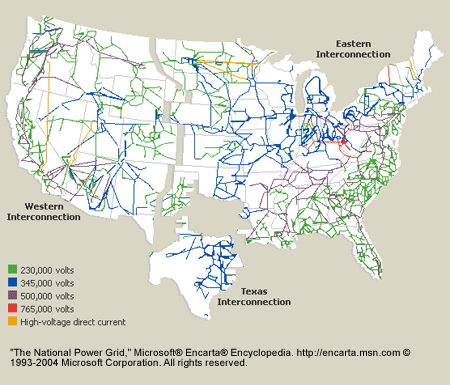In our first two posts, we talked about how our reliance on turbine technology and carbon-fueled generation is not going to be going away anytime soon, even though it is inefficient. Our next few posts will be looking at the problem of power distribution. The growth of alternative energy technology has fueled a movement toward distributed generation over grid distribution, which is what we more commonly employ. Grid power in the US comes mostly in direct current (DC) generation, resulting from Thomas Edison winning the debate over the benefits of DC power offer Nikola Tesla’s alternating current (AC). We are not going to get into the benefits of one over the other here but will, instead, talk about what is. We have a massive investment in most of the US in DC generation. The exceptions are most of the state of Texas, which has a unique grid system capable of handling both, as well as a small portion of southern Alaska and some of the northeastern states.

DC is easier to distribute power over long distances. All grid systems have a certain amount of electricity loss but AC tends to lose more power than DC over distance. The problem with alternative power and most of the grid in the US is that alternative power cannot be sent to where it is needed when it is needed. It must be localized or “boosted” along the line. With large grid-scale facilities, like many of the photovoltaic facilities being built in the Southwestern deserts, that becomes a significant issue.
Distributed generation is a concept becoming more popular because it fits better into the uses of alternative power generation. Quite simply, it means you generate the power adjacent to where it is needed. If you put solar panels or wind generators on your property, you are a distributed-generation facility. That causes significant problems for the grid.
First, your solar panels are producing AC power, similar to what your handheld device uses, but your home is set up for DC. You have to add an inverter to your home to change the AC into DC so it can be used in your home and placed on the grid. Second, as we mentioned previously, the power you produce isn’t necessarily when you or the grid actually needs the power, so the utilities cannot rely on the power you produce being available when it is needed. An AC grid would be able to better distribute your excess energy, as it does in Texas, but most of us are not on an AC grid so we have to make do with what we have. We have invested far too much in the infrastructure to rip it out and install a new one.
That brings us to the owners and stewards of the grid: Utility companies. Power generation has become a major headache for utilities that draws resources and money away from grid maintenance (in other words, the powerless and towers criss-crossing the country). There has been little investment in upgrading the grid because of it, but it remains a significant source of income for utilities, especially as the distributed power network grows. When it looked like they could make money off of people who generated power with alternative energy, by buying it cheaply and selling for a profit, they were more than willing to offer sweetheart deals to companies like SunPower, but as we have pointed out earlier, the profits have not been forthcoming and the deals, known as net-metering, are going away.
At the same time, some utilities are looking at getting out of the generation game altogether. PG&E in Northern California has made no secret that it is not only not building any new generation facilities, it is selling off what it does have to independent companies, with an eye to upgrading distribution infrastructure. The utility actually buys much of the power it delivers to customers from out-of-state power plants. While this practice makes financial sense for the utilities as well as for the integrity of the grid, it means higher power bills for customers including those who have already invested in alternative sources. The big losers in this paradigm shift will be the solar and wind companies that have relied on a steady steam of investment and revenue from the utilities.